Porcelain Insulator News
by Elton Gish
Reprinted from "Crown Jewels of the Wire", March 1999, page 61
Bob Kay reported an unusual pair of markings on U-400B. Most of you are
probably asking, "What is U-400B?" This is a good time to report this
new style. For those who have the Value Guide for Unipart and Porcelain
Insulators, you can find the scale drawing on page 101. The first and only
specimen of U-400B I have seen was unmarked and had a rather unattractive
chocolate brown glaze. It was nothing exciting and didn't really merit reporting
in PIN. I suspected it was made by Illinois Electric Porcelain Co. but couldn't
be sure. Bob found a white U-400B which has the two under-glaze ink markings
shown below in Bob's close-up photo.
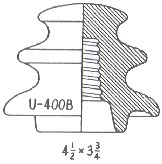
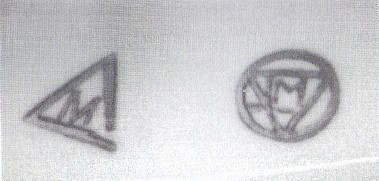
U-400B with under-glaze ink markings: triangle M and Line Material.
I always suspected that there must be other U-400B's in collections and that
no one recognized that this fairly common looking style was a new style for the
U-Chart. It is odd to have two different markings on the same insulator. The
under-glaze ink triangle M marking was used in the 1915-20 time period. The
under-glaze Line Material marking was used 1958-1967 when they operated the
insulator factory old Illinois Electric Porcelain plant in Macomb, IL. The parent
company of Line Material was McGraw-Edison Co. The under-glaze ink Line Material
markings used during this time period also include the year of manufacture. So,
the under-glaze ink marking found on U-400B with the triangle M marking is
different because it doesn't include the year.
Jim Crandall (NIA #297) sent me a
copy of a page from his undated Line Material catalog No. 28. The catalog has
several patents in it with the last patent dated 1927. I suspect the catalog was
published in 1928. An illustration of U-400B is shown in this catalog. It is
described as a "Loop Insulator" to be used for arc light circuits. It
appears that Line Material designed the U-400B and had it produced by Illinois
Electric Porcelain Co. That would explain why both markings appeared on this one
insulator. I feel certain that Bob's U-400B was made in the late 1920's.
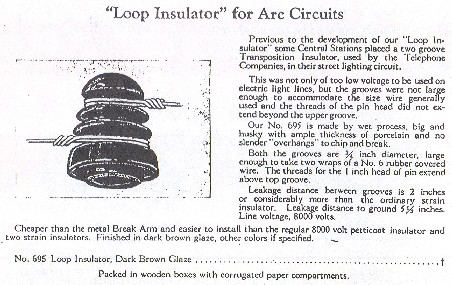
"Loop Insulator" shown in Line Material Catalog No. 28.
I don't
know if other insulators exist with the under-glaze ink Line Material marking
and without the year date. If they do, you might suspect they were made during
this same time period rather than the much later time period (1958-67) when Line
Material was making their own insulators. Bob's insulator is a significant find not just for the
U-400B but tying Illinois to
early Line Material insulators. Illinois also produced a wide variety of dry
process porcelain in odd non-pintype styles which were probably sold by Line
Material. Line Material sold all types of odd hangers, brackets, lag screw
insulators, tree insulators, etc. Obviously Line Material and Illinois had a long
running working relationship.
Richard D' Alanno (NIA #5935) had a very exciting
time last October on a one-day trip to Newell, WV with his sister and mother.
Richard reported, "We stopped at the Homer Laughlin China Co. along the
Ohio River with the old B&O Railroad running alongside the building. I walked along the old railroad bed hoping to
find a CD 136 in yellow olive. green. I had no luck! When I went to check on my mom and sister in the Homer Laughlin
Plant, I asked the workers if they ever made insulators. They said no, but a
plant down the street called the Newell Porcelain Co. still makes porcelain
insulators. When I visited the company, I told the president, John R. Roberts,
that I collect insulators. He gave me a blue Newell Porcelain Co. cap. They make
large substation insulators. Then Mr. Roberts told me about the old Thomas dump
in Lisbon, OH and he drew me a map. I left Newell, WV and drove to Lisbon, OH
(just across the river). When I got to the dump site, I met one of Thomas'
grandsons. He didn't own the dump site. I was amazed to see hundreds of
porcelain insulators that were dug up from a nearby creek. To my surprise, I
found insulators that look like the ones that are pictured on the cover of
December 1997 Crown Jewels! I picked up four standard cap and pin suspension insulators. One is a light blue color and the other three are
chocolate colored. It was a dream come true exploring and digging in the old
dump."
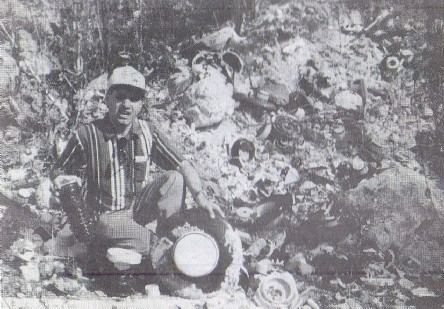
Richard D' Alanno with some potential keepers from the Thomas dump.
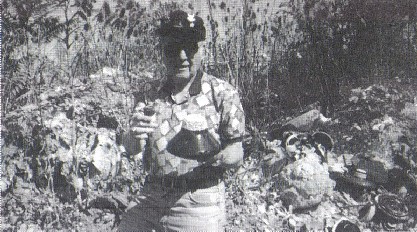
Richard's father found a couple of smaller interesting insulators.
Richard called very excited when he returned home. I can imagine his
excitement. Who wouldn't enjoy digging through an insulator dump site. It really
wouldn't matter if you found a real jewel or not. Included here are a few photos
that Richard took when he returned with his father. Most of the insulators
probably failed the electrical test. I didn't see any metal caps or pins on the
suspension insulators.
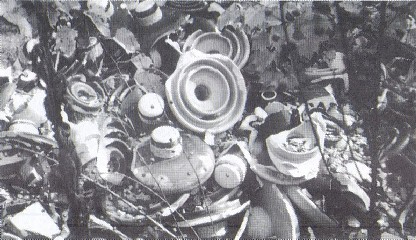
Close-up view of a pile of broken Thomas insulators in the dump.
Mike Parker sent a couple of photographs of his two gray M-3451's with Ohio
Brass embossed marking on the crown. Mike had a good question: Did Akron make
these gray O-B's. I never thought of that before when trying to tie down the age
of the gray multis. O-B took over the Akron in July 1907 and announced that all
production would be marked with their logo. So your O-B M-3451's were made after
July 1907. That same big logo marking is found on M-4395, which I know was made
in 1909 for a line in the northeast. M-4395 is gray, too. You said the M-3451 's
were installed in the Portland, OR area (Bull Run Dam line) sometime in
1909-1911, which agrees with all we know about the gray multis. Back to your
question about Akron manufacture, O-B published their first catalog of
production from Akron in Oct. 1907; however, O-B did not acquire Akron until
August 1910 after Akron's losses put them in bankruptcy. I believe that your
M-3451 's were indeed made by Akron H-P. I think that the manufacture of gray
multis was dropped about 1910-12. During the survey for the Value Guide, only
three gray O-B M-3451's were reported. You reported two and Robin Harrison (NIA
#3911) reported one. I haven't received any reports since then about others
being found or otherwise coming into the hobby. I've been continually updating
the listing for the Value Guide as a way to keep track of new reports. Most any
gray multi is quite valuable today and will only grow in value because of their
age and attractive glaze. Very few gray multis remain in the air.
We simply do
not know when companies started making gray multis. In unipart styles, we do
know that white glaze was essentially banned in 1901 in favor of
"brown" glazes which "offered less of a target to hunters".
It seems to me that a brown insulator would make a better target. Brown would
show up better than white against the sky when trying to sight your gun on the
insulator. I have no idea what the thought was on using a gray glaze. It seems
to go against the common thinking on glaze color at that time unless people
considered uniparts to be predominately in rural areas on lower poles where the
backdrop would be trees. In that case brown would blend in with the darker
background of tree limbs and leaves. Multipart insulators would be used on power
lines which naturally would be on much taller poles and predominately have a
gray or blue sky background. In that case a gray glaze would blend in with the
background and provide a poorer target. I suspect that gray insulators were
mostly used in the western states where there was a predominance of open sky. I
only recall gray multis being used back east in two instances. One was a line in
northeast which used M-2902 and the line which used M-4395 (to replace dark
brown M-3890 which suffered greatly from lightning strikes).
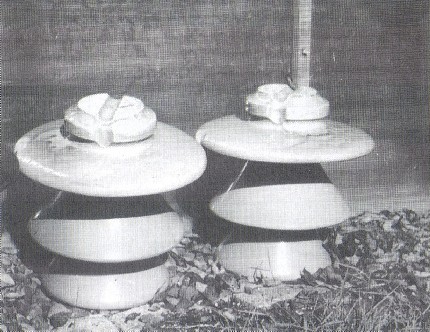
Two gray M-3451's made by Ohio Brass made circa 1909-1911.
One last report this month is quite significant. Robin Harrison (NIA #3911)
is an avid collector of Fred Locke and other early porcelain. Some of you may be
familiar with the rare, white, 2-part glazeweld U-196 with Fred Locke
under-glaze ink marking #6-3. This marking has six of Fred Locke's patents. As
explained in my book, Fred M. Locke: A Biography, the Fred Locke under-glaze ink
markings were actually made by Electric Porcelain & Manufacturing Co. after
Fred Locke stopped buying porcelain insulators from Imperial in late 1897.
Production for Fred Locke probably ended sometime in the first half of 1900.
U-196 was shown in an advertisement in the December 1899 issue of American
Electrician (see page 104 of my book).
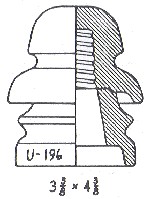
U-196 is quite rare. Only six specimens are known plus one other that was
heavily damaged and cut in half to learn more about the glazeweld (see previous reports in
CJ: 2-91-18 and 11-92-15). All U-196's found to date have been marked on the
crown. Robin now reports he has three U-196' s (included in the total count of
six) which are all marked in different locations: dome, middle skirt, and bottom
skirt. It is unheard of to have one specimen of such a rare insulator but to
have three uniquely marked specimens is unbelievable!!! The picture below should
cast away any doubts about Robin's claim!
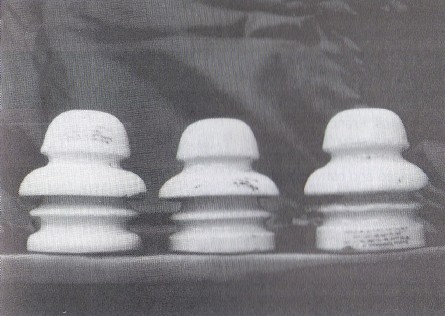
Three very rare white U-196's with under-glaze ink Fred Locke
marking #6-3
struck In three different locations:
dome, middle skirt, and bottom skirt.
| 